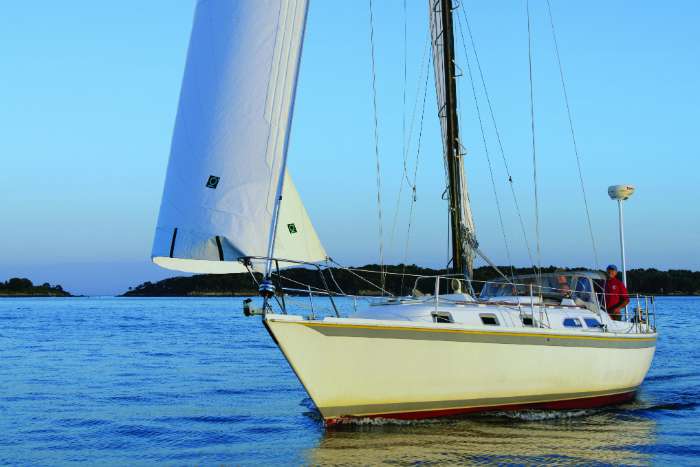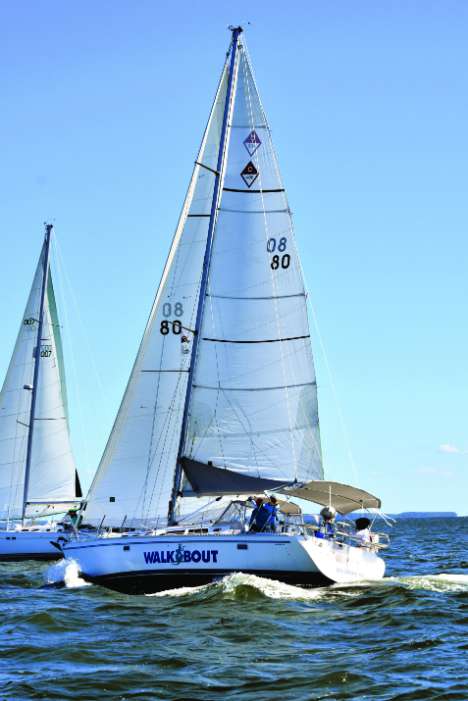What Can Cruisers Learn From Racing Sailors About Sail Trim and Speed?
This column is usually dedicated to the arcane matters that captivate racing sailors. Riveting subjects like mainsail twist, mast bend, rig tuning, or my wife’s personal favorite, “headstay sag.” Sure to cause a listener’s eyes to glaze over. We are easily amused. But since this issue of SpinSheet is largely dedicated to the cruising side of our sport, I thought it would be a good time to pass on some techniques that racing sailors take for granted that will make a cruising sailor’s life more fun. Racing sailboats forces you to become a better sailor. You can get away with a lot as a cruiser. Try these tips and you will feel more comfortable and get more out of your time on the water.

The sails steer the boat
Anyone who has sailed a small boat has had this lesson pounded in the hard way. Try to bear off in any kind of breeze in a dinghy without easing the sails, and you probably end up swimming. If you have only grown up sailing bigger cruising boats, you can use the big rudder and righting moment to simply overpower the sails. Of course, as it gets windy, this equation changes. Suddenly the sails are much bigger than the rudder. Your cruising boat becomes at the mercy of the sails as if it were a dinghy. To bear off you need to ease the sheets generously. Whatever it takes to reduce heel and unload the helm. Ideally when you head up, you want to let the sails do the work, trimming as you go. Though you can let the luffing of the sails make them easier to pull in.
Upwind trim
The basic concept when trying to sail upwind is to sheet the sails in hard so that you can sail the closest angle to the wind possible. But there are limits. First, you can’t sheet as hard in lighter winds or whenever the boat is slow for that matter. The boat needs to move through the water for the keel to work. If you over-trim, you will never get going. Start eased a bit. Gradually trim once you get up to speed. Remember the golden rule: “speed first; then pointing.” This also means you can’t pinch (try to cheat and sail extra high) in light to moderate conditions. You may want to get to that upwind destination, but you just can’t force it. Make sure the headsail telltales are streaming aft and use them to guide your steering.
Conversely, as it gets windy, you can shift from the telltales to the boat’s angle of heel. Once up to speed you can trim hard and maintain a constant angle of heel. Don’t fight the helm. Let the boat coast up in the puffs to keep it on its feet in the puffs. Let the telltales lift on the inside or even carry a tiny bit of luff. Bear off in the lulls. This technique is called “feathering.”
Reaching trim
Don’t over-trim! The most common mistake is to have the sails pulled in too far. Remember the first thing they drilled in when you were learning. “Let it out until it luffs. Bring in just enough to stop.” Pulling the sails in does not create power. It simply makes them stall. It also makes the sail forces go sideways and less in line with where you want the boat to go. You will be surprised about how far out they can go. Long before you are dead downwind the mainsail can probably be all the way out. For headsails, one of the most simple, powerful tools is to set up a reaching lead on the rail or as far outboard as you can go. Use a second sheet. This allows the lead to pull down properly so that the top of the sail doesn’t open up and luff (twist). It also creates space so you can ease the mainsail further without luffing. Lead position for reaching will be slightly forward of normal upwind setting.

Halyard tension
On a cruising boat we may not have all the cool tools to help adjust and refine trim, but some are common to all. I have been on hundreds of boats to do sail checks for new cruising sails, and one thing constantly astounds me. On the vast majority I find the halyards neatly coiled and tied off at the mast; where they have been since the sail was first hoisted or put on the furling system. Halyard tension has never been adjusted for sailing conditions. Unfortunately, one size does not fit all. Halyard tension (luff tension) needs to change as a function of apparent wind velocity. No matter what you make a sail out of there is going to be stretch in both the sail and the halyard.
The great thing is that it is simple to get right. This is not like tuning a violin. Look up at the luff and ease the halyard until you have wrinkles beginning to emanate perpendicular to the luff. Then, take up just enough tension to smooth them out. Since amount of tension required is a function of apparent wind velocity, you will probably need to make a change based on point of sail. Upwind higher apparent wind will require more tension. You can ease off when reaching and running. Keep the active halyard on a winch for easy adjustment. If adding tension, let the sail luff so that you do not have to fight it. Maintaining proper luff tension will help power up the boat in light air and de-power as it gets windier.
Downwind
Just point and go right? It’s not that simple. In light air (under 10 knots) you will have little or no apparent wind to fill the sails if you try to go anywhere close to dead downwind. You need to head up to generate apparent wind velocity. This means tacking downwind as opposed to going straight. You will sail more distance but at a much faster (and more pleasant) rate. The basic rule is to head up far enough to create pressure and fill the sails. Fall off too far, and the clew will drop. You need to strike a balance, sailing as low as possible while maintaining a full sail.
Obviously, the type of sail you have up will make a big difference. This is where asymmetric spinnakers are the right tool for the job. Bigger, lighter, and more powerful than any upwind headsail, they are made for tacking downwind and will allow you to sail much broader angles in less wind. Once the wind builds to 10-12 knots, you will create enough apparent wind to sail more directly downwind. At this point, poling out an upwind headsail with a whisker pole becomes a good option, though an asymmetrical will still work well. #
Questions? Email [email protected]




